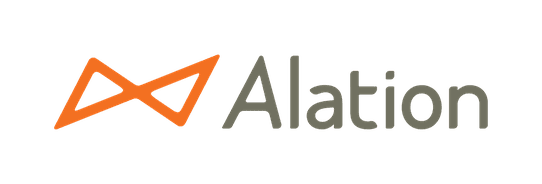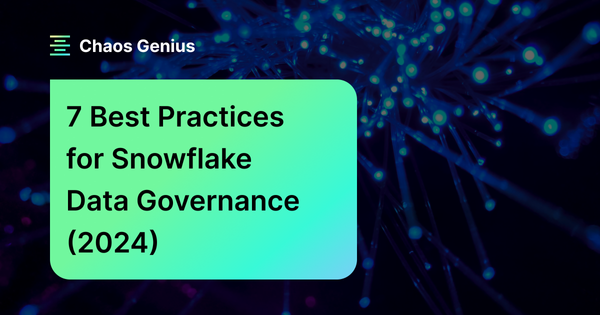Data is ruling the world, but with the staggering amount of data being generated and stored, can we trust it all? As data continues to grow at an exponential rate, the complexities and challenges surrounding it are becoming increasingly apparent. This is exactly where data governance comes in—ensuring that data is managed and used correctly to maintain accuracy, security, and quality.
In this article, we will learn about what is meant by "Snowflake data governance", explore the best practices for effective Snowflake data governance, and get a brief overview of Snowflake's built-in data governance features to help businesses maintain the integrity and security of their data within the Snowflake platform.
What is Snowflake Data Governance?
To understand Snowflake Data Governance, it is necessary first to understand the concept of Data Governance in general.
What is Data Governance?
Data governance is a set of practices, processes, and regulations that control how data is gathered, kept, used, and shared. It involves creating policies and regulations for how data is gathered, stored, shared and used; this includes setting rules around who can access the data and under what conditions they are allowed to do so. Data governance also establishes processes to ensure that all of an organization's data is accurate and safe so that users can make decisions based on accurate information.
Data governance is critical for safeguarding sensitive data and ensuring it is secure, compliant and high-quality. It lowers data breaches and misuse while improving data quality, allowing for discovering relevant data insights. Good data governance is essential in regulated industries such as healthcare, banking, and finance because it ensures data traceability and prevents unauthorized access or removal.
What are the benefits of having a data governance strategy in place?
- Data reliability: Good practices for data governance help make sure data is correct, consistent, and reliable, allowing businesses to make better-informed decisions based on reliable data.
- Data compliance with regulations: Businesses are bound by regulations/standards that govern how data should be kept and secured. Data governance ensures these requirements are followed, which can help prevent legal complications and massive penalties/fines.
- Data security: Data breaches can be costly and detrimental to a business's reputation. Effective data governance practices can improve data security by controlling access to sensitive information and protecting it from unauthorized disclosure or data misuse.
- Data efficiency and productivity: Data governance helps ensure that data is available when and where it is needed, which cuts down on wasted work and might boost productivity.
- Data decision-making process: Data governance helps businesses make better decisions and achieve their objectives more effectively by providing them with reliable and accurate data.
Now, let's jump back to understanding the concept of Snowflake data governance.
What is Snowflake data governance?
Snowflake data governance refers to the policies, procedures, and practices that can be implemented to guarantee proper management and control of data stored on the Snowflake Platform. To keep the integrity and value of data, Snowflake data governance needs a full-scale approach that includes data security, data quality, and data management.
Snowflake data governance is fundamentally about creating and following rules about accessing, protecting, and using data. This includes establishing roles and permissions to manage who can access and update data on the Snowflake environment. Users can also leverage the powerful features provided by Snowflake, such as Virtual Private Snowflake (VPS), and third-party services, such as PrivateLink (not affiliated with Snowflake), to safeguard their data better and make sure only authorized users are allowed to access it.
Overview of built-in Snowflake governance features:
1) Column-level security
Column-level security feature in Snowflake is only available in the Enterprise edition or higher. It provides enhanced measures to safeguard sensitive data in tables or views. It offers two distinct features, they are:
- Dynamic Data Masking hides plain-text data in tables and views columns based on masking policies at query runtime. These schema-level policies prevent unauthorized access to sensitive data while letting authorized users access sensitive data at query runtime. The policies use conditions and functions to transform the data when conditions are met.
- External Tokenization is a feature that enables accounts to tokenize data before loading it into Snowflake and detokenize the data at query runtime. Tokenization is the process of removing sensitive data by replacing it with an undecipherable token. External tokenization makes use of masking policies with external functions. Before data can be loaded into Snowflake, it must be tokenized by a third-party tokenization service. At query execution, Snowflake uses the external function to make an API call to the tokenization provider, which then analyzes an externally-created tokenization policy before returning tokenized or detokenized data depending on the masking policy conditions.
What is Masking Policy?
Masking policies are schema-level objects that protect sensitive data from unwanted access while allowing authorized users to view the sensitive data during query execution. These masking policies are made up of conditions and functions that change data during query execution when the given criteria are met.
Masking policies can be applied to one or more columns in a table or view that have the same data type. Masking policy conditions can be expressed using Conditional Expression Functions and Context Functions or by querying on a custom table.
In short, Snowflake's column-level security enables users to apply masking policies to protect sensitive data in tables or views. This feature grants access and visibility only to authorized users who need it, through a flexible policy-driven approach that allows secure control over the data.
2) Row-level access policies/security
Row-level security is a feature in Snowflake that enables administrators to limit access to particular rows in tables/views based on a set of policies defined in the schema. These policies can be basic or sophisticated, depending on the specific security requirements.
Note: Row-level security feature in Snowflake is also only available in the Enterprise edition or higher.
A row access policy is also a schema-level object that controls whether a given row in a table or view is accessible through SELECT operations or by UPDATE, DELETE, and MERGE operations. The policy can include conditions and functions to transform the data at query execution time if the conditions are satisfied. This policy-driven approach is intended to encourage the partitioning of tasks to enable teams (especially Snowflake governance teams) to develop regulations limiting the exposure of sensitive data. Typically, the object owner or role with the OWNERSHIP privilege on the object has complete access to the underlying data. Yet, row access policies can override this access and limit the visibility of specific rows in the query result.
You can add a row access policy to a table or view either when the object is created or after the object is created. The policy admin can easily apply row access policies to tables and views.
Check out this official Snowflake documentation to learn more about the Row level policy and how it works.
TLDR; Snowflake's row-level security is a powerful way to control access to sensitive data at a granular level. It ensures that only authorized users or roles can see or access specific rows of data in a table or view.
3) Object tagging
Object-tagging feature in Snowflake is also only available in the Enterprise edition or higher. To define what "object tags" are, they are simply labels that allow you to assign metadata to Snowflake objects, such as tables, views, and schemas, by using tags. Tags are essentially labels that consist of key-value pairs. These tags can be used to categorize and describe Snowflake objects, making them easier to manage and organize.
Check out this official Snowflake documentation to learn more about the in-depth process of Object tagging and its benefits.
Snowflake object tagging offers several benefits, with one of the main benefits being the ability to inherit tags based on where they are applied. On top of that, it also has numerous advantages, including tracking and finding sensitive data, classifying data and objects, tracking resource consumption, adding row-level security, tag-based masking data—and much more!!
TLDR; Object tagging in Snowflake enables efficient data categorization and organization using labels called "tags," providing benefits such as tracking sensitive data, implementing access policies, and simplifying Snowflake governance
4) Object tag-based masking policies.
Tag-based masking policies in Snowflake make it possible to apply a masking policy automatically to all columns with a specific tag. This feature makes protecting data easier because it eliminates the need to apply a masking policy to each column by hand or manually. A tag-based masking policy is created using the ALTER TAG command, which allows you to associate a masking policy with a specific tag.
Whenever a column is tagged with the tag associated with a masking policy, the policy is automatically applied to that particular column. The masking policy will only get applied if the column's datatype matches the datatype specified in the masking policy signature. If a column has both a directly assigned masking policy and a tag-based masking policy, the directly assigned policy takes precedence. Also, it is recommended to create a generic masking policy for each data type supported by Snowflake, such as STRING, NUMBER, and TIMESTAMP; this policy should specify how authorized roles can see the raw data while unauthorized roles can see a fixed masked value. This simplifies the initial process of column data protection.
Learn more about it from here: Snowflake official documentation
TLDR; Tag-based masking policies make protecting data easier by applying a masking policy automatically to all columns that have a certain tag; this feature ensures consistent data protection across all columns that share the same tag.
5) Data classification
Data classification feature in Snowflake is also only available in the Enterprise edition or higher. Data classification in Snowflake is a feature that allows users to automatically identify and classify columns in their tables containing personal or sensitive data.
The classification process involves three main steps: analyze, review, and apply. The first step, analyze, involves calling the EXTRACT_SEMANTIC_CATEGORIES function to analyze the columns and output possible categories and associated probabilities. The second step, 'review,' involves validating the results, while the third step, 'apply,' involves assigning system tags to columns containing personal or sensitive data.
Check out the official Snowflake documentation, to learn more about the data classification.
6) Object dependencies
Object Dependencies is a built-in Snowflake governance feature that allows users to identify dependencies among Snowflake objects.
In Snowflake, an object dependency is established whenever an existing object needs to reference some metadata on its behalf or for at least one other object. A dependency can be triggered by an object's name, its ID value or both.
Object Dependencies enables users to view and track these dependencies between Snowflake objects, which is particularly useful for impact analysis, data integrity assurance, and compliance purposes.
Learn more about it from here: Snowflake official documentation
Object Dependencies are a really important feature for compliance officers and auditors who need to trace data from a given object to its original data source to meet regulatory requirements.
7) Access History
Access History feature in Snowflake is also only available in the Enterprise edition or higher. Access History is a built-in Snowflake governance feature that provides a record of all user activity related to data access and modification within a Snowflake account. Essentially, it tracks user queries that read column data and SQL statements that write data (INSERT, UPDATE, DELETE). The Access History feature is particularly useful for regulatory compliance auditing and also provides insights into frequently accessed tables and columns.
The Access History feature in Snowflake is available through the Account Usage ACCESS_HISTORY view.
Check out the official Snowflake documentation, to learn more about Access History.
TLDR; Access history features help users easily maintain a detailed record of all data access and modification events within their Snowflake accounts.
Best Practices for Implementing Snowflake Data Governance
1) Use Snowflake's built-in governance features effectively
Snowflake offers a range of built-in governance features that can be used to ensure that data is properly classified, secured, and audited. These features include object tagging, dynamic data masking, row access policies, and object dependencies. It is crucial to understand and use these features effectively to ensure that data is appropriately governed.
2) Data policies and procedure
Data policies and procedures are essential for ensuring data is managed and governed effectively. These policies and procedures should cover various areas such as data quality, data privacy, data security, data retention, and data access. The policies and procedures should be reviewed and updated regularly to ensure that they remain relevant and effective.
3) Establishing Effective Snowflake Data Governance Team
To establish effective Snowflake data governance, it is crucial to create a dedicated Governance Council/Committee that will serve as the governance team. This team will develop and enforce cross-functional rules and procedures to ensure data is managed effectively. It is important that each team member has a clearly defined role and responsibility.
Here are some essential roles to consider:
- Stakeholders
- Data stewards
- Data managers
- Data custodians
- Compliance officers
- Data Architects
- Information Security Officers
- Data Quality Analysts
So, by forming a Snowflake governance team with these key roles, businesses/organizations can ensure that their Snowflake data governance program is effective and aligned with the needs of the business.
4) Develop a data governance framework
A data governance framework should be developed to ensure that data is managed and governed in a consistent and structured manner. The framework should include policies, procedures, guidelines, and standards used to manage and govern data across the organization. The framework should also include roles and responsibilities for data governance and a process for managing data governance issues and escalations.
5) Implement Security measures
Security measures are essential for protecting data from unauthorized access or breaches. Organizations/businesses should implement various security measures such as access controls, encryption, data masking, and more! It is also crucial to establish a security monitoring and incident response process to ensure that any security incidents are detected and responded to in a timely manner.
6) Maintain Data Quality standards
Maintaining data quality standards is important for ensuring that data is accurate, consistent and reliable. Organizations should establish data quality standards and implement processes to monitor and maintain data quality. This includes processes for data validation, data cleansing and data enrichment.
7) Implementing automation and monitoring tools
Automation and monitoring tools can improve the efficiency and effectiveness of governance processes. For example, automated processes can be used to apply data classification tags to objects based on specific criteria or to enforce row-level access policies whereas Monitoring tools can be used to track access to data, detect security incidents, and monitor data quality.
Tools Used for Effective Snowflake Governance
1) Collibra
Collibra is an enterprise-oriented data governance tool that helps businesses and organizations understand and manage their data assets. It enables businesses and organizations to create an inventory of data assets, capture metadata about 'em, and govern these assets to ensure regulatory compliance. The tool is primarily used by IT, data owners, and administrators in charge of data protection and compliance to inventory and track how data is used. Collibra's aim is to protect data, ensure it is appropriately governed and used, and eliminate potential fines and risks from a lack of regulatory compliance.
Collibra's mission is to help businesses secure their data, ensure appropriate governance and utilization, and eliminate potential fines and risks associated with noncompliance with regulatory requirements. So, by integrating Collibra with Snowflake, enterprises can effectively manage their data assets within Snowflake by leveraging Collibra's governance capabilities. This combination enables data democratization and enterprise-wide collaboration, while also enabling businesses to easily discover and scale access to reliable data. The unique features and complementary capabilities of both platforms empower businesses to increase data usage, collaboration, and ultimately deliver faster insights and innovation, all while ensuring proper governance of their data within Snowflake.

Collibra offers six key functional areas to aid in data governance:
- Collibra Data Quality & Observability: Monitors data quality and pipeline reliability to aid in remedying anomalies.
- Collibra Data Catalog: A single solution for finding and understanding data from various sources.
- Data Governance: A location for finding, understanding, and creating a shared language around data for all individuals within an organization.
- Data Lineage: Automatically maps relationships between systems, applications, and reports to provide a comprehensive view of data across the enterprise.
- Collibra Protect: Allows for the discovery, definition, and protection of data from a unified platform.
- Data Privacy: Centralizes, automates, and guides workflows to encourage collaboration and address global regulatory requirements for data privacy.
2) Alation
Alation is a sophisticated data catalog solution designed for enterprise-level organizations, acting as a unified reference for all their data needs. It automatically scans and indexes over 60 distinct data sources, encompassing on-premises databases, cloud storage, file systems, and business intelligence tools.
Utilizing query log ingestion, Alation analyzes queries to pinpoint the most frequently accessed data and its primary users. This information forms the foundation of the catalog, which allows users to collaborate and contextualize the data. With the catalog established, data analysts and scientists can swiftly locate, scrutinize, validate, and repurpose data, enhancing their productivity.
However, Alation's capabilities extend beyond a mere data catalog solution. It also serves as a data governance platform, enabling analytics teams to effectively manage and enforce policies for data consumers. Through Alation's comprehensive metadata management, organizations can establish and enforce policies, monitor usage, and maintain compliance with data privacy regulations. Its adaptable workflows and dashboards empower governance teams to effortlessly create, modify, and disseminate policies, ensuring responsible data usage across the enterprise.
Alation is an optimal solution for Snowflake data governance, as it centralizes data, fosters collaboration, and enforces adherence to data access and usage policies. This leads to heightened productivity and innovation, making Alation an invaluable resource for organizations seeking efficient Snowflake data governance.

Key benefits of using Alation:
- Boost analyst productivity
- Improve data comprehension
- Foster collaboration
- Minimize the risk of data misuse
- Eliminate IT bottlenecks
- Easily expose and interpret data policies
Alation offers various solutions to improve productivity, accuracy and data-driven decision-making. These include:
- Alation Data Catalog: Improves the efficiency of analysts and the accuracy of analytics, empowering all members of an organization to find, understand, and govern data efficiently.
- Alation Connectors: A wide range of native data sources that speed up the process of gaining insights and enable data intelligence throughout the enterprise. (Additional data sources can also be connected with the Open Connector Framework SDK.)
- Alation Platform: An open and intelligent solution for various metadata management applications, including search and discovery, data governance, and digital transformation.
- Alation Data Governance App: Simplifies secure access to the best data in hybrid and multi-cloud environments.
- Alation Cloud Service: Offers businesses and organizations the option to manage their data catalog on their own or have it managed for them in the cloud.
Conclusion
Snowflake data governance is essential for ensuring data quality, security, and accuracy. Snowflake provides a comprehensive set of features to help businesses implement data governance, but these features must be combined with an effective strategy. In this article, we defined Snowflake data governance, discussed best practices for implementation, and provided an overview of the built-in and third-party tools available to support Snowflake data governance.
You can think of Snowflake Governance as a fence protecting your data garden from any trespassers. Use it to your full advantage to create reliable data security measures and data access controls, safeguarding the privacy of your sensitive data stored in Snowflake.
FAQs
What is Snowflake data governance?
Snowflake data governance refers to the policies, procedures, and practices implemented to manage and control data stored on the Snowflake Platform. It ensures data integrity, security, and management.
What are the advantage of having a data governance strategy?
Advantage of data governance strategy include improved data reliability, compliance with regulations, enhanced data security, increased data efficiency and productivity, and better decision-making based on accurate data.
What are the key features of Snowflake's built-in data governance?
Snowflake's built-in data governance features include column-level security, row-level access policies/security, object tagging, object tag-based masking policies, data classification, object dependencies, and access history.
What are some best practices for implementing Snowflake data governance?
Best practices include effectively using Snowflake's built-in governance features, establishing data policies and procedures, forming a governance team, developing a data governance framework, implementing security measures, maintaining data quality standards, and leveraging automation and monitoring tools.
Which tools can be used for Snowflake data governance?
Snowflake can be integrated with a range of security and governance tools, such as Collibra, Alation, and others.






































